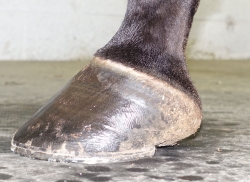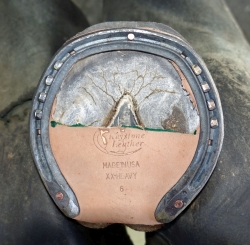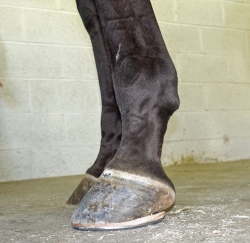Deciding if a horse should wear a wedge pad or shoe is a delicate thing. Putting a wedge on a hoof that is already low in the heels increases the forces that have previously broken those heels down.
The improvement of a wedged hoof is usually quite temporary—often only aesthetically improved—and can lead to an even more decimated heel quality. I find this is always the outcome when wedging high/low syndrome (front feet, one clubby or upright, the other low-heeled and under-slung).
 Fig. 1: This pacing filly has a hoof on a much lower plane angle than the pastern, necessitating a wedge.
Fig. 1: This pacing filly has a hoof on a much lower plane angle than the pastern, necessitating a wedge.
For years I tried wedging the low heel on these horses to only end up compounding the problems with that low heel. I have found better results by bringing the break-over back more, by squaring the toe on the low-heeled hoof and supporting the weakened heels with some type of bar shoe.
Dr. Esco Buff, an equine podiatrist from New York, advocates lengthening the high-heeled hoof with flat (non-wedged) pads to help even the load on the two front hooves. Dr. Buff considers this situation to be a limb length disparity. I have seen gait improvement in some horses by doing this, but have had limited success improving the hoof abnormalities. I will say that if one considers the upright, narrow, clubby hoof to be atrophied, then Dr. Buff’s method makes perfect sense to me.
 Fig. 2: Wedging heels can help keep the hoof and pastern aligned, promoting soundness.
Fig. 2: Wedging heels can help keep the hoof and pastern aligned, promoting soundness.
“Running down” is another wedge situation. Running down is when the back of the hind ankle touches the ground when racing or training. Wedge pads or shoes can help this problem. Caution is to be taken here because the farther you wedge the heel up, the more space is created for the suspensory apparatus to sink, thereby increasing risk of injury to that structure. It is definitely a delicate balance between addressing the damage done by running down and the potential injury of the ankle sinking deeper over a wedged hoof.
The scenario for which I believe wedges to be an absolute necessary evil is in Fig. 1. This is a front hoof on a pacing filly that was deep into a racing campaign. The relationship between the pastern and hoof is severely broken back, meaning the hoof is on a much lower plane angle than the pastern.
 Fig. 3: The filly in Fig. 1 after the wedges were applied.
Fig. 3: The filly in Fig. 1 after the wedges were applied.
This is a potentially dangerous situation. It creates an excessively delayed break-over, increases time on the ground during each strike, and puts undue pressure on the deep digital flexor tendon (DDFT). The DDFT extends farther distally (lower) than the Superficial Digital Flexor tendon (SDFT). The DDFT passes over the navicular region and attaches to a semilunar crest in the back of the coffin bone. Because of this attachment, the DDFT is affected by hoof angle more than its counterpart, the SDFT, which is the bowed tendon culprit.
While the horse in Fig. 1 does not have any issues with DDFT, she is not performing close to her talent level and is by no means 100-percent sound. We decided it was a no-brainer to wedge this horse up.
Pulling the break-over back and wedging the heels (Fig. 2) has the horse much closer to normal hoof/pastern alignment and improved both gait and soundness (Fig. 3). While a wedged shoe and/or pad is an imperfect application, it does have its place in shoeing horses when the upside benefit to the lower limb outweighs the downside detriment that the wedge does to the hoof itself.
I also think that the bar wedge style shown in Fig. 2 helps to reduce the negative impact of a wedge on the heels of a hoof. To me, the difference in stance between Fig. 1 and Fig. 3 makes the decision an easy one. Some fillies just look better in heels.
Veteran Standardbred farrier Steve Stanley of Lexington, Ky., authors a monthly column for Hoof Beats, the official harness racing publication of the U.S. Trotting Association. The American Farriers Journal Editorial Advisory Board member offers plenty of practical advice that will be of special interest regardless of the type of horses that you work with. Click here to read more from Steve Stanley's Hoof Beats series.








Post a comment
Report Abusive Comment